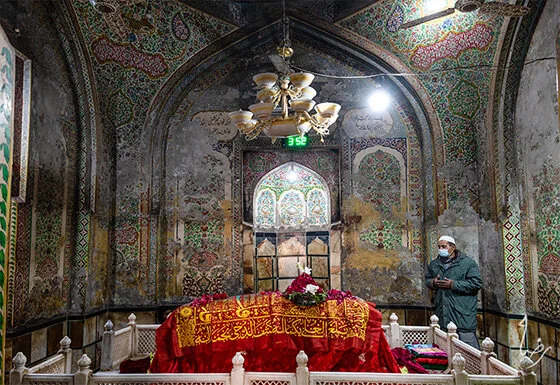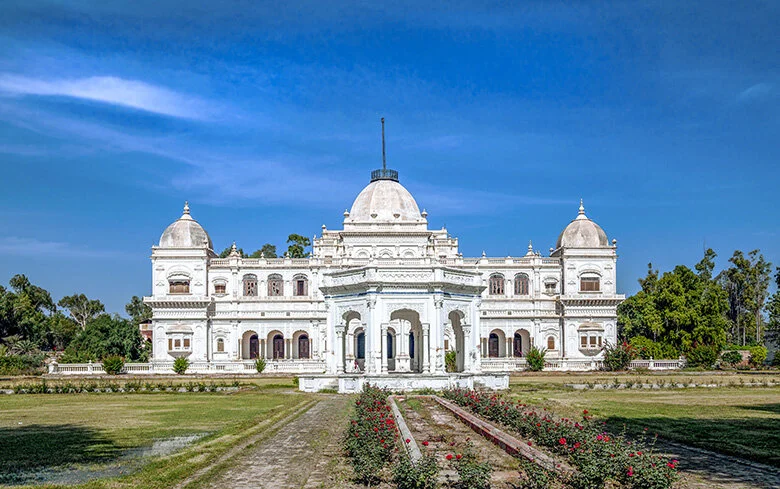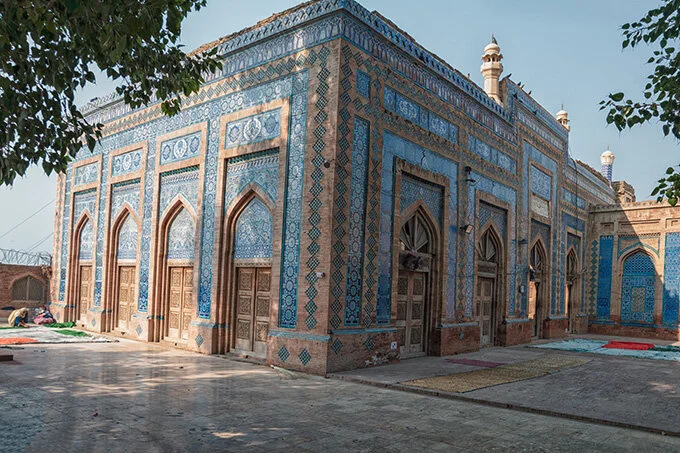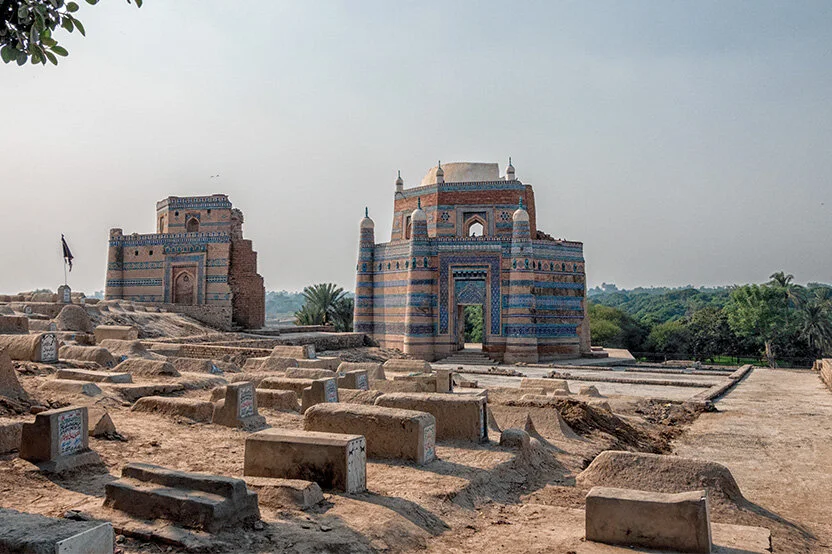SOUTH PUNJAB
One can’t discuss legends, myths, folklore, and Sufism in Pakistan without mentioning South Punjab. South Punjab isn’t only rich in culture and heritage but has a distinct culture that stems from the ancient civilizations that once resided there. Places such as the Hakra-Indus Civilizations, the Harappan sites, mounds, medieval forts, palaces, and walled towns play a pivotal role in adding to the region’s culture. Literature, traditional dance, devotional music, and different cultural rites play an integral role in the lives of the local communities.
Now, let’s shed some light on how cities in South Punjab are submerged in their heritage and culture.
MULTAN
Regarded as one of the oldest continuously inhabited cities of the world, Keshap Puri (Multan) was capital was built by the Aryan king Kashyap, later Hindu Kings had built temple of sun in which idol of sun was laid.
Multan has always been a point of conflict since the beginning of time due to its location between South Asia and Central Asia which makes it susceptible to invasion. Multan changed hands between invaders, starting from Alexandar in 326 BCE, the Alchon Huns in the 5th century, followed by the Arabs in 712 who brought Islam and Sufism to the region. Then several muslim dynastys, leading to the Mughals, then the Afghans, the Skihs and finally the British until Multan became part of Pakistan in 1947.
Todays Multan is known for its old fort and tombs, and the excellent institute of blue pottery, and several other traditional handicrafts. It has six historic gates: Pak Gate, Haram gate, Delhi gate, Daulat gate, Bohar gate, Lohari gate. In the middle of the city is the Multan Fort, which separates the fort from River Ravi. Multan Fort was once considered one of the best forts of the sub-continent with 1.6 km long walls, sadly it now only has remnants left as the walls were destroyed by the British Garrison station. The highest point in Multan is located on the west side of the fort showing a bird’s view of the city.
Many Influential saints have lived in Multan. One such Sufi saint was Bahauddin Zakariya, an 11th-century Sufi saint, scholar, and poet, who became one of the most influential spiritual leaders of his era. Zakariya’s shrine’s architectural style has a white dome covering the octagonal landing.
Another reputable Sain was Shah Rukhn-e-Alam who dedicated his life to the teachings of Islam. His shrine is located behind the ruins of Multan Fort. His shrine serves as a historic monument depicting pre-Mughal architecture, heavily influenced by Persian and Central Asian architectural styles.
Another shrine of Sufi Saint, Syed Shah Yousaf Gardezi, considered the founder of Modern Multan, is located on the southwest outskirts of the city. His shrine is constructed in typical Multani architecture and is decorated with blue glazed tiles. The “City of Saints” is home to several tombs and shrines, embellished with rich architecture and fine details
Outside the walls of the city, several other heritage sites can be found such as the shrines of Sultan Ali Akbar and his mother, the shrine of Ismali Sufi Saint, and Shah Shams Sabswari. The city has 20 shrines in total.
Within the historic center there is Damdama (Now Multan Art Gallery) a massive block of a building constructed on a mound of earth fill. It is highest part of Fort Kohna and was used as watch tower. The views overlook a British era clock tower which now houses the Multan Museum.
BAHAWALPUR
Known as “The city of palaces” and located in the south of Sutlej River, Bahawalpur was founded in 1748 by Muhammad Bahawal khan. Bahawalpur was ruled by the Abbasi family of Nawabs till 1955 and became the capital of the former princely state of Bahawalpur. This region has also been a part of the Yaudheya kingdoms of the Mahabharat. At one time in history, a major part of the region was part of the holy city of Uch Sharif.
Due to its rich history, many historical sites with distinct architectural styles can be found in Bahawalpur. One such example is of the residential palaces, official Durbars, Public libraries, and even old hospitals whose architecture has been influenced by The Nawab rule and their inclination towards European architectural style.
Another historical site is Nur Mahal which was constructed in 1872 for the beloved wife of Nawab Sadiq Muhamad Khan. The Palace was built to resemble the Italian chateaus, along neoclassical lines, including a rectangular front porch, followed by a double delighted square entrance foyer and a domed crowned.
One such more palace is Sadiqgarh Palace which was built during 1882-1895. It is a three-storied palace, with an architectural blend of Mughal and European style. However, it is off-limits for the public.
The Bahawalgarh Palace complex is a majestic residency of Nawabs, built under the rule of Ameer Muhammad Bahawal Khan Abbassi the fifth. The complex is comprised of three palaces in which Durbar Mahal is the largest. Other palaces are the Farrukh Mahal and Nishat Mahal which are domestic in nature.
The Central Library of Bahawalpur was built in 1924, on the orders of Sadiq Muhammad Khan to transform the city into a center of excellence and learning. The library contains almost 100,000 books, audio-visual archives, and century-old National newspapers. It also has a collection of historic documents about the state of Bahawalpur and Khawaja Ghulam Fareed – a 19th century Sufi Poet. There is also a newly established Quran gallery that exhibits the entire Quran hand-painted by a local calligrapher named Mohammad Younis Ansari.
Remains from the Indus valley civilization can still be found in Bahawalpur. The historic city once had seven gates, of which only the Farid Gate remains. The city’s heritage and soulful history make it worthy of our visit at least once in our lifetime.
UCH SHARIF
Uch was founded by Alexander the Great, in 325 BCE as Alexandria on the Indus. The city was built near the Panjand (where all the Indus rivers meet) and it is approximately 80 km from Bahawalpur,
In 712 CE when Muhammad Bin Qasim invaded the region and introduced Islam, Uch became home to various Scholars and Sufi Saints after which it became famous for saints and shrines. It is believed that the concept of shrines in Uch is keenly followed to date.
Among many remarkable sites, the Uch monument complex is a famous compound, which has over 1400 cemented graves and has shrines. Shrines of famous personalities such as Bibi Jawindi, Jahaniyan Jahan-Gasht, Abdul Aleem, Ustad Nooriyan, and Jamaluddin Bukhari can be found there.
Of these graves, the most notable tomb belongs to Syed Jamaluddin Bukhari, a 14th-century father-saint of South Punjab. The residential quarter has hosted various wandering Sufis, including the famous Bulleh Shah. The brick-built tomb was built in a vernacular style, with a roof embellished with floral and geometric designs. The tombs have domes over octagonal bases, depicting elements of Tughlaq military architecture. The site has been on the tentative list of UNESCO World Heritage sites for quite some time now.
Of the many tombs, the tomb of Baha’Al-Halim is the oldest tomb that was built by his pupil. Another shrine in the vicinity belongs to the world-wanderer, Jahaniyan Jahan-Gasht who marched to Mecca 36 times to perform the pilgrim. The tomb of her granddaughter Bibi Jawindi was built by an Iranian Prince.
The tomb compound of Uch Sharif was initially a dessert. However, due to the massive canal network and man-made tributaries, the surrounding area turned lush green with cultivation, making the whole site mesmerizing.
DERAWAR FORT
The Derawar Fort is a 9th-century fort located 130 km from Bahawalpur. The Desert Forts of Cholistan are up to a dozen medieval forts in south-eastern Pakistan, of which Derawar Fort is the best known and best preserved. It is located in the middle of the Cholistan desert. This fort was built by Rai Jajja Bhatti, as a tribute to Rawal Deoraj Bhatti - a Rajput Sovereign king. There is also a local legend about the lost treasure of Derawar; a treasure hidden by Prince Rawal who built the fort in 850.
In the 18th century, the fort was invaded by Muslim Abbasi Nawabs and rebuilt by Nawab Sadiq Khan in 1732. The 12th and the last ruler of Bahawalpur State, Nawab Sadiq Khan Abbasi V, was born in this fort in 1904.
The magnificent forty bastions of the fort are visible from miles away in the Cholistan desert. The walls are 30 meters high and are built with red bricks. The complex structure of the fort consists of an underground tunnel network, connecting Derawar to other forts in the desert. This tunnel network was once accessible through a staircase and served as a secret escape for rulers during wars.
A mosque named Abbasi Masjid is located right outside the gate of the fort. The architecture of the mosque is inspired by Shah Jahan’s Moti (pearl) Masjid in Agra. This mosque comprises three domes and four minarets. Its structure is built of beautiful white marble.
The fort is still possessed by the Abbasi family, and being private property only permitted individuals can visit the fort. An annual off-road Cholistan Desert jeep Rally is established near the fort which attracts national and international visitors during winters.











